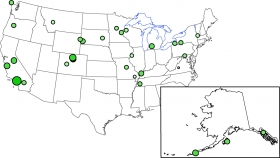Low Levels of Fallout from Fukushima Release

There is always concern when something radioactive is released as to what its downwind effects might be. Certainly there are effects at the actual site but thousands of miles away? Fallout from the 2011 Fukushima Dai-ichi nuclear power facility in Japan was measured in minimal amounts in precipitation in the United States in about 20 percent of 167 sites sampled in a nationwide study released today. The U.S. Geological Survey led the study as part of the National Atmospheric Deposition Program (NADP). Levels measured were similar to measurements made by the U.S. Environmental Protection Agency in the immediate days and weeks following the March 2011 incident, which were determined to be well below any level of public health concern at the time by EPA. \
Many NADP sites are located away from major urban areas so that they are more representative of the U.S. landscape as a whole. This study is complementary to EPA results, and together these data will allow for a better picture of the deposition of radioactive fallout across the United States.
"Japan's unfortunate nuclear nightmare provides a rare opportunity for U.S. scientists to test an infrequently needed national capability for detecting and monitoring nuclear fallout over a wide network," explained USGS director Marcia McNutt. "Had this been a national incident, NADP would have revealed the spatial and temporal patterns of radioactive contamination in order to help protect people and the environment."
Precipitation was collected at monitoring sites within the geographically extensive NADP network. USGS scientists detected Iodine -131, Cesium-134, and Cesium-137, the primary radioactive products released during an incident such as this one. These detections were most frequently found along the West Coast, in the central and northern Rocky Mountain States and the eastern United States where precipitation fell most heavily in the weeks after the Fukushima disaster.
This is the second time samples from the NADP network have been used to measure radioactive fallout. The first time was after the Chernobyl disaster in 1986 which was slightly larger release. The release of two types of radioactive particles in the first 3-4 days of Japan's nuclear crisis was estimated to have reached 20-50 percent of the amounts from Chernobyl in 10 days. The NADP network allows scientists to sample fallout at a wide range of sites, including rural and isolated areas.
"This analysis provides scientifically valid measurements of radioactive fallout in precipitation over North America, which helps add more details to the picture of fallout in the U.S in the weeks following the Fukushima incident," said Greg Wetherbee, USGS chemist who led the study. "NADP and USGS demonstrated that this network enhances national capabilities to monitor radionuclides in precipitation following releases to the atmosphere."
For further information: http://www.usgs.gov/newsroom/article.asp?ID=3111&from=rss&utm_source=feedburner&utm_medium=feed&utm_campaign=Feed%3A+UsgsNewsroom+%28USGS+Newsroom%29&utm_content=Google+Reader
Photo: USGS
©2012. Copyright Environmental News Network To subscribe or visit go to: http://www.enn.com